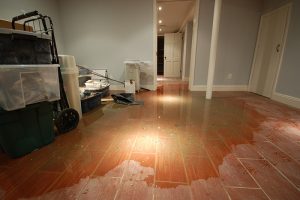
Unexpected water in your basement can damage walls and floors, destroy carpeting, ruin furniture and other valuables. If not properly cleaned up and treated, it can also lead to mold. When you experience a flooded basement for the first time, it's important to determine if the problem is going to recur or if it was a one-time event.
Where did this water come from?
Outside of obvious flooding around your home and in your neighborhood, there are four common sources of water entering basements:
- Surface water running down foundation walls.
- Groundwater in water-saturated soils being pushed into the basement by hydrostatic pressure.
- Storm sewer from the municipal storm sewer system backing up into the home's existing perimeter foundation drain and leaking into the basement.
- Sanitary sewer from a clog in your home's sewer line, the municipal sewer line, or the combined municipal storm/sanitary sewer system backing up into the home's drain system, causing sewer water to come up through sink drains and floor drains on lower levels.
Each source has its own specifics and requires its own course of action.
Surface Water:
If this is the first instance of moisture problems in your basement, the first thing to check for is surface water draining down next to the foundations. If it is coming in at one location or only at the exterior foundation wall indicates surface water problems. Here are some things to look for once you get outside.
Leaves and debris- Keeping gutters clean of debris should be a part of every homeowner's routine maintenance program. Depending on the surrounding trees, gutter cleaning may be required a few times a year.
Overflowing Gutters:
Downspouts- If you don't mind getting wet, you can do a self-check (your gutters must be cleaned out first). After at least 15 minutes of heavy rain, check your gutters. If you see any water overflowing, you have a problem.Any overflowing out of the gutters is running down next to the house foundations. Even if the water is not getting into the basement, it could be eroding soil from under the house footings, which can lead to cracking of walls and ceilings.
Downspout Distance:
Downspouts should extend 10 feet from your home. While many homeowners do not like downspouts extending out this far, 10 feet is the minimum distance needed to discharge rain coming off your roof far enough away from the house.
Pavement Slope:
Sometimes paving settles over time and water flow can change direction toward the house. If this is the case, the paving should be removed and replaced so it slopes away from the home.
Landscape Slope:
Does your yard or the land around your home slope away from your home? It should. Look for any depressions in the ground next to the home foundation walls. If any are found, fill in with dirt so the water drains away from the house. Use a clay-type soil that sheds water instead of sandy soil that allows water to soak into the ground. Make sure that at least eight inches is kept between the top of the earth and any wood or stucco on the house.If there are large hills nearby sloping toward your home, and you think they may be causing the problem, a civil engineer may be required to analyze the situation and determine the appropriate solutions.
Irrigation:
Avoid placing lawn irrigation next to the house. If this cannot be avoided, instruct the installer to limit the amount of water dispersed next to the house. Make sure the irrigation system includes a working rain gauge so the system does not turn on when there has already been plenty of rain for the plants and lawn.
Controlling Subsurface Groundwater:
If no surface water sources are found, then the source of the water is likely subsurface groundwater under hydro-static pressure. Unfortunately, subsurface groundwater problems are more difficult and more expensive to fix than surface groundwater problems.When the groundwater levels outside the basement rise above the level of the floor, the basement acts like a boat in a pond. If a boat is sitting in water, water will leak in through any open cracks or holes. It works the same way with a basement. Hydro-static pressure can push water through hairline cracks. Symptoms of this are water coming up through cracks in the basement concrete floor or water coming in at multiple locations.If you have an older home within town and the house has a basement with no sump pump, it is likely the perimeter foundation drain system connects directly into the city storm sewer system. If the level of the basement is below the street level, there is the potential of storm water backing up in the city storm sewer system and being pushed into the perimeter foundation drain system. This can saturate the soils around the house at the basement level with storm water under hydro-static pressure, causing water to leak in.
Storm Water Back-up:
In many older homes with basements, there is a perimeter foundation drain outside the exterior wall, at the level of the basement floor, next to the footings at the time the house was built. A pipe was usually installed from the perimeter foundation drain to the street where it was connected to the city storm sewer system. This can become a problem as the city storm sewer system becomes too small when more development causes more rain runoff. When this happens, the rainwater in the sewer system can get so high that it flows backwards toward the house.Typically, the installation of an interior perimeter basement drain system connected to a sump pump will take care of the problem. If it doesn't, the (more expensive) alternative is to dig up and cap the pipe that is running from the house to the street from the perimeter foundation drain. However, this is not always possible. Many times, this pipe is also draining sanitary waste from toilets and sinks in the house.If you believe you have this problem, contact an experienced contractor for advice.
Sewer Water Back-up:
If the water is coming up through floor drains or sink drains in the basement, then the problem is often water backing up from the municipal sanitary sewer system. During heavy rains, combined sewer systems can become overwhelmed. This can cause sewer water to back up in the system and sometimes into homes.Sewer backups can be caused by individual service lines being plugged by grease, waste, tree roots, breaks in pipes or saturated ground. Sewer mains can also be plugged by vandalism or large items dropped down manholes.This kind of flooding is an enormous problem for homeowners, as it's largely out of your control and probably means fecal waste backing up into basements. Not only is it disgusting, but it can also be a serious health hazard.In order to keep your individual lines clear, you can install preventers that help stop sewer waste from flowing backward into the house. Proper maintenance of your individual lines - for example, pouring tree root killer down your toilets once a year - can also go a long way in preventing sewage backups. Still, the problem is often out of your control.Sewage in your basement means a major cleanup and a lot of uncertainty about future problems. If it's something you've seen in your home, you'll have to get your city government involved. At the very least, be aware of the problem and don't leave anything valuable near your downstairs drains.If you experience a water loss of any kind in your home, call the professionals at
Thompson Building Associates. Proudly serving Franklin and the surrounding counties since 1978, our team can get your home and life back to normal in no time.
Information found in this article was obtained from various sources not associated with Thompson Building Associates or ResQ 24. While we believe it to be reliable and accurate, we do not warrant the accuracy or reliability of the information. These suggestions are not a complete list of every loss control measure and the information is not intended to replace manuals or instructions provided by the manufacturer or the advice of a qualified professional. Thompson Building Associates and ResQ 24 make no guarantees to the results of this advice.

